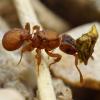what's a macro lens?
Its a camera lens that can take pictures of things at a closer distance than a normal lens, its good for taking pictures of bugs and stuff, you can buy them for a camera or use a clip on one for a iPhone, I use a clip-on lens for my phone, you can buy them on amazon for pretty cheap, just search up "clip on macro lens for iPhone" on amazon
Oh! I might try that


















